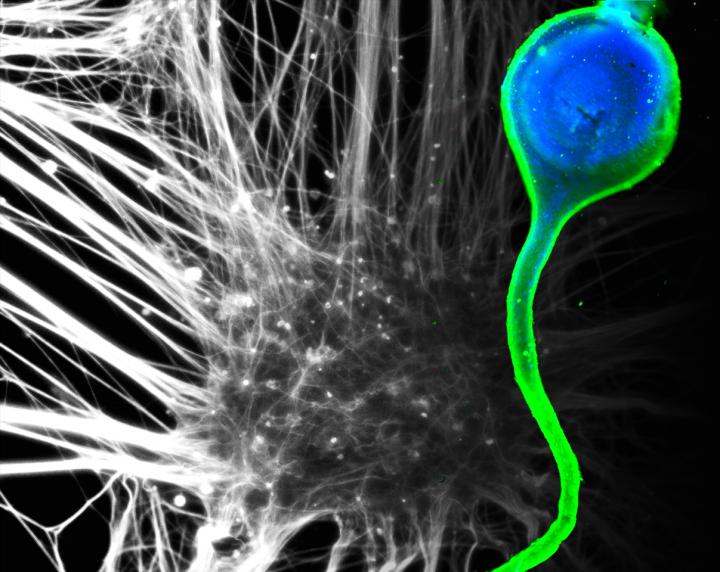3-D axon assemblies pave the way for drug discovery

Motor nerve-like tissue (right) was generated using human induced pluripotent stem cell-derived motor neurons (left). Credit: 2017 Jun Kamei and Yoshiho Ikeuchi, Institute of Industrial Science, The University of Tokyo Usage Restrictions: Related to the press release only
Axons are the structures through which neurons transmit information to other cells. In the body, they aggregate to form fascicles. Several technologies allow scientists to generate and study single axons in the lab, but none are effective at creating nerve fascicles. A collaboration between researchers in Japan and the United States has led to a new microdevice that successfully forms fascicles in the lab. The report, which can be read in Stem Cell Reports, is expected to provide important insights on brain development and disease.
“We know that growing axons form fascicles, but we do not know how fascicles form,” says Yoshiho Ikeuchi, a lecturer at the Institute of Industrial Science at the University of Tokyo and senior author of the study.
Many scientists have examined axon development and degeneration in two-dimensional (2D) systems. However, it is becoming increasingly apparent that the fascicle's 3D structure has an essential role in axon function. Because fascicles are disrupted in many neurodegenerative diseases such as ALS, the research group theorized that understanding their formation could give clues on the prevention of a number of diseases.
To form axon fascicles, the research teams manufactured a microdevice in which human neurons derived from induced pluripotent stem cells were injected. What allowed for the formation of the fascicles was the preparation of neural spheroids and a channel narrow enough to align axons, which let them bind to each other.
Spheroids were placed inside the chamber of the device. Axons grew from these spheroids, with some entering the microchannel. Upon this entry, other axons would spontaneously follow, leading to the formation of fascicles that showed properties consistent with those seen in brains. What molecular signaling caused the spontaneous entry remains unexplained, but fascicles were detected in more than 90% of experiments, convincing the researchers the value of the microdevice design.
“The device gives us a means to investigate which factors are responsible for the fascicle assembly,” says Ikeuchi.
Accordingly, they simulated neurodegenerative conditions by introducing into the channels peroxide, and the fascicles responded with morphological changes.
These findings and the relative ease of the experiments suggest the microdevice will be applicable to testing experimental drug compounds that prevent fascicle degeneration caused by disease.
###
The article, “Generation of a Motor Nerve Organoid with Human Stem Cell-Derived Neurons” was published in Stem Cell Reports at http://dx.
Links:
Institute of Industrial Science, The University of Tokyo
Research contact:
Yoshiho Ikeuchi, PhD, Lecturer
Institute of Industrial Science, The University of Tokyo
4-6-1 Komaba
Meguro-ku, Tokyo 153-8505
Japan
Tel: 81-3-5452-6330
yikeuchi@iis.u-tokyo.ac.jp
Press officer contact:
Megumi Ijichi
Public Relations Office
Institute of Industrial Science, The University of Tokyo
4-6-1 Komaba
Meguro-ku, Tokyo 153-8505
Japan
Tel: 81-3-5452-6738
Fax: 81-3-5452-6746
pro@iis.u-tokyo.ac.jp
About the University of Tokyo:
The University of Tokyo is Japan's leading university and one of the world's top research universities. The vast research output of some 6,000 researchers is published in the world's top journals across the arts and sciences. Our vibrant student body of around 15,000 undergraduate and 15,000 graduate students includes over 2,000 international students. Find out more at http://www.
Media Contact
All latest news from the category: Life Sciences and Chemistry
Articles and reports from the Life Sciences and chemistry area deal with applied and basic research into modern biology, chemistry and human medicine.
Valuable information can be found on a range of life sciences fields including bacteriology, biochemistry, bionics, bioinformatics, biophysics, biotechnology, genetics, geobotany, human biology, marine biology, microbiology, molecular biology, cellular biology, zoology, bioinorganic chemistry, microchemistry and environmental chemistry.
Newest articles

Can lab-grown neurons exhibit plasticity?
“Neurons that fire together, wire together” describes the neural plasticity seen in human brains, but neurons grown in a dish don’t seem to follow these rules. Neurons that are cultured…

Unlocking the journey of gold through magmatic fluids
By studying sulphur in magmatic fluids at extreme pressures and temperatures, a UNIGE team is revolutionising our understanding of gold transport and ore deposit formation. When one tectonic plate sinks…

3D concrete printing method that captures carbon dioxide
Scientists at Nanyang Technological University, Singapore (NTU Singapore) have developed a 3D concrete printing method that captures carbon, demonstrating a new pathway to reduce the environmental impact of the construction…



